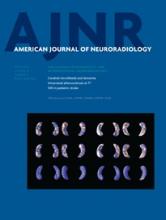Research ArticleNeurointervention
Extra-Aneurysmal Flow Modification Following Pipeline Embolization Device Implantation: Focus on Regional Branches, Perforators, and the Parent Vessel
G. Gascou, K. Lobotesis, H. Brunel, P. Machi, C. Riquelme, O. Eker, A. Bonafé and V. Costalat
American Journal of Neuroradiology April 2015, 36 (4) 725-731; DOI: https://doi.org/10.3174/ajnr.A4191
G. Gascou
aFrom the Department of Neuroradiology (G.G., P.M., C.R., O.E., A.B., V.C.), CHU Gui de Chauliac, Montpellier, France
K. Lobotesis
bDepartment of Imaging (K.L.), Imperial College Healthcare NHS Trust, Charing Cross Hospital, United Kingdom
H. Brunel
cDepartment of Neuroradiology (H.B.), CHU La Timone, Marseille, France.
P. Machi
aFrom the Department of Neuroradiology (G.G., P.M., C.R., O.E., A.B., V.C.), CHU Gui de Chauliac, Montpellier, France
C. Riquelme
aFrom the Department of Neuroradiology (G.G., P.M., C.R., O.E., A.B., V.C.), CHU Gui de Chauliac, Montpellier, France
O. Eker
aFrom the Department of Neuroradiology (G.G., P.M., C.R., O.E., A.B., V.C.), CHU Gui de Chauliac, Montpellier, France
A. Bonafé
aFrom the Department of Neuroradiology (G.G., P.M., C.R., O.E., A.B., V.C.), CHU Gui de Chauliac, Montpellier, France
V. Costalat
aFrom the Department of Neuroradiology (G.G., P.M., C.R., O.E., A.B., V.C.), CHU Gui de Chauliac, Montpellier, France

REFERENCES
- 1.↵
- Deutschmann HA,
- Wehrschuetz M,
- Augustin M, et al
- 2.↵
- Fischer S,
- Vajda Z,
- Aguilar Perez M, et al
- 3.↵
- Lubicz B,
- Collignon L,
- Raphaeli G, et al
- 4.↵
- McAuliffe W,
- Wenderoth JD
- 5.↵
- Nelson PK,
- Lylyk P,
- Szikora I, et al
- 6.↵
- Szikora I,
- Berentei Z,
- Kulcsar Z, et al
- 7.↵
- Chalouhi N,
- Tjoumakaris S,
- Starke RM, et al
- 8.↵
- Becske T,
- Kallmes DF,
- Saatci I, et al
- 9.↵
- Kallmes DF,
- Ding YH,
- Dai D, et al
- 10.↵
- D'Urso PI,
- Lanzino G,
- Cloft HJ, et al
- 11.↵
- 12.↵
- Roszelle BN,
- Gonzalez LF,
- Babiker MH, et al
- 13.↵
- Shobayashi Y,
- Tateshima S,
- Kakizaki R, et al
- 14.↵
- Cebral JR,
- Mut F,
- Raschi M, et al
- 15.↵
- Hampton T,
- Walsh D,
- Tolias C, et al
- 16.↵
- Siddiqui AH,
- Kan P,
- Abla AA, et al
- 17.↵
- Velat GJ,
- Fargen KM,
- Lawson MF, et al
- 18.↵
- Puffer RC,
- Kallmes DF,
- Cloft HJ, et al
- 19.↵
- Lee DH,
- Arat A,
- Morsi H, et al
- 20.↵
- Yu SC,
- Kwok CK,
- Cheng PW, et al
- 21.↵
- 22.↵
- Dai D,
- Ding YH,
- Kadirvel R, et al
- 23.↵
- Lopes DK,
- Johnson AK
- 24.↵
- Roszelle BN,
- Babiker MH,
- Hafner W, et al
- 25.↵
- Appanaboyina S,
- Mut F,
- Löhner R, et al
- 26.↵
- Sadasivan C,
- Cesar L,
- Seong J, et al
- 27.↵
- 28.↵
- Kallmes DF,
- Ding YH,
- Dai D, et al
- 29.↵
- van Rooij WJ,
- Sluzewski M
- 30.↵
- Phillips TJ,
- Wenderoth JD,
- Phatouros CC, et al
- 31.↵
- 32.↵
- Lieb M,
- Shah U,
- Hines GL
- 33.↵
- 34.↵
- 35.↵
- 36.↵
- 37.↵
- 38.↵
- Chiu AH,
- Wenderoth J
- 39.↵
- Karapanayiotides T,
- Meuli R,
- Devuyst G, et al
- 40.↵
- Murakami H,
- Inaba M,
- Nakamura A, et al
- 41.↵
- Levitt MR,
- McGah PM,
- Aliseda A, et al
- 42.↵
- Cruz JP,
- Chow M,
- O'Kelly C, et al
- 43.↵
- Kulcsár Z,
- Houdart E,
- Bonafe A, et al
- 44.↵
- Velat GJ,
- Fargen KM,
- Lawson MF, et al
In this issue
American Journal of Neuroradiology
Vol. 36, Issue 4
1 Apr 2015
Advertisement
G. Gascou, K. Lobotesis, H. Brunel, P. Machi, C. Riquelme, O. Eker, A. Bonafé, V. Costalat
Extra-Aneurysmal Flow Modification Following Pipeline Embolization Device Implantation: Focus on Regional Branches, Perforators, and the Parent Vessel
American Journal of Neuroradiology Apr 2015, 36 (4) 725-731; DOI: 10.3174/ajnr.A4191
0 Responses
Extra-Aneurysmal Flow Modification Following Pipeline Embolization Device Implantation: Focus on Regional Branches, Perforators, and the Parent Vessel
G. Gascou, K. Lobotesis, H. Brunel, P. Machi, C. Riquelme, O. Eker, A. Bonafé, V. Costalat
American Journal of Neuroradiology Apr 2015, 36 (4) 725-731; DOI: 10.3174/ajnr.A4191
Jump to section
Related Articles
- No related articles found.
Cited By...
- Flow-Diversion Treatment for Unruptured ICA Bifurcation Aneurysms with Unfavorable Morphology for Coiling
- Flow modification on the internal carotid artery bifurcation region and A1 segment after M1-internal carotid artery flow diverter deployment
- Role of distal cerebral vasculature in vessel constriction after aneurysm treatment with flow diverter stents
- Flow diversion covering the M1 origin as a last resort
- Pipeline embolization device treatment of internal carotid artery terminus aneurysms
- Flow diversion for anterior choroidal artery (AChA) aneurysms: a multi-institutional experience
- Middle cerebral artery flow velocity increases more in patients with delayed intraparenchymal hemorrhage after Pipeline
- Large Basilar Apex Aneurysms Treated with Flow-Diverter Stents
- Flow diversion of bifurcation aneurysms is more effective when the jailed branch is occluded: an experimental study in a novel canine model
- Virtual-versus-Real Implantation of Flow Diverters: Clinical Potential and Influence of Vascular Geometry
- Endovascular treatment of ophthalmic artery aneurysms: ophthalmic artery patency following flow diversion versus coil embolization
- Posterior Inferior Cerebellar Artery Patency after Flow-Diverting Stent Treatment
- Intravenous C-Arm Conebeam CT Angiography following Long-Term Flow-Diverter Implantation: Technologic Evaluation and Preliminary Results
- Retrospective Analysis of Delayed Intraparenchymal Hemorrhage after Flow-Diverter Treatment: Presentation of a Retrospective Multicenter Trial
This article has not yet been cited by articles in journals that are participating in Crossref Cited-by Linking.
More in this TOC Section
Similar Articles
Advertisement











